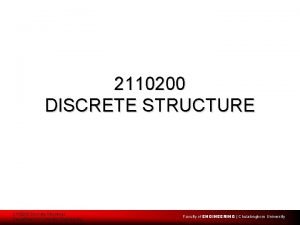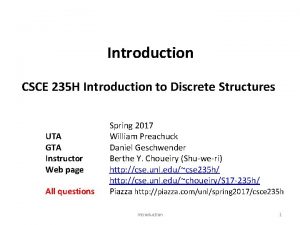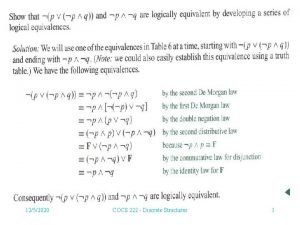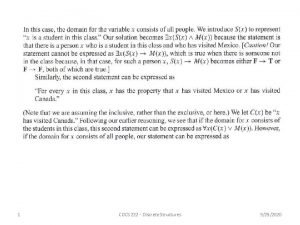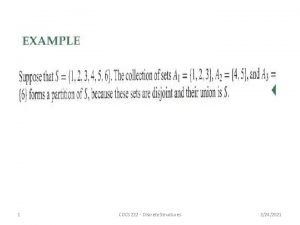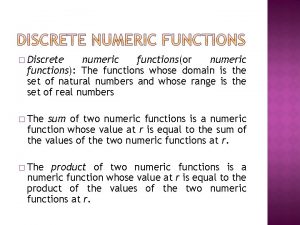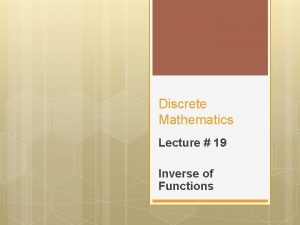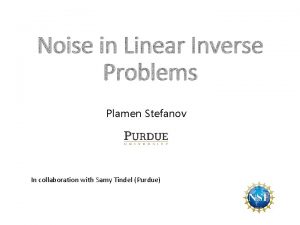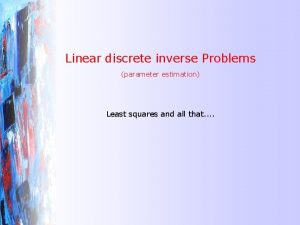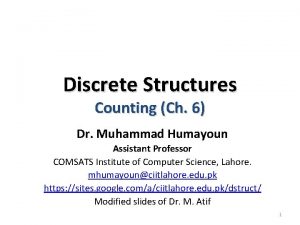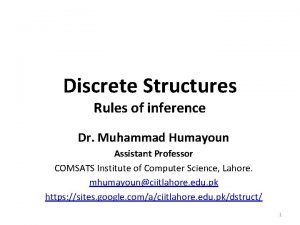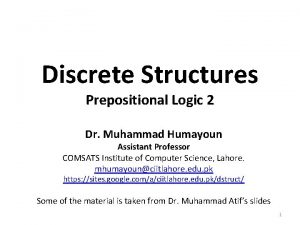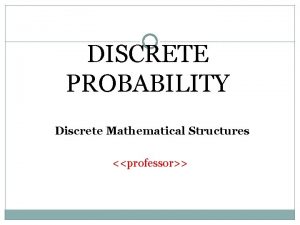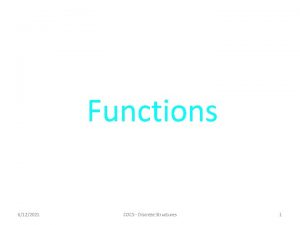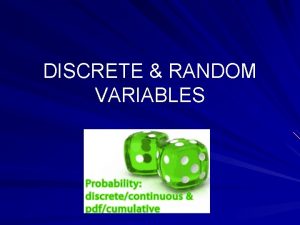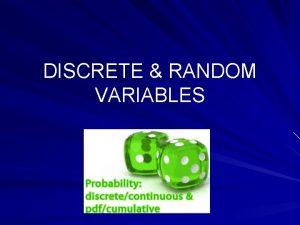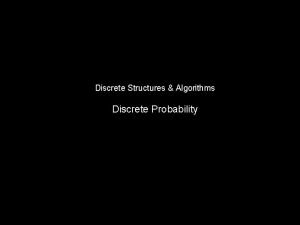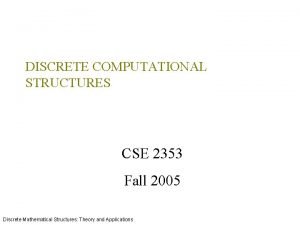Discrete Structures Functions Dr Muhammad Humayoun Assistant Professor

































- Slides: 33

Discrete Structures Functions Dr. Muhammad Humayoun Assistant Professor COMSATS Institute of Computer Science, Lahore. mhumayoun@ciitlahore. edu. pk https: //sites. google. com/a/ciitlahore. edu. pk/dstruct/ A lot of material is taken from the slides of Dr. Atif and Dr. Mudassir 1

Recall the Cartesian Product • All ordered n-tuples (2 tuples in our example) • Let S = { Ali, Babar, Chishti } and G = { A, B, C } • S×G = { (Ali, A), (Ali, B), (Ali, C), (Babar, A), (Babar, B), (Babar, C), (Chishti , A), (Chishti , B), (Chishti , C) } – A relation • The final grades will be a subset of this: – { (Ali, C), (babar, B), (Chishti, A) } 2

Grade Assignment Ali Babar Chishti A B C 3

Function • This assignment is an example of a function • A function is a set of ordered pairs in which each x-element has only ONE y-element associated with it • The concept of a function is extremely important in mathematics and computer science 4

Definition 1 Let A and B be nonempty sets. A function f from A to B is an assignment of exactly one element of B to each element of A. We write f (a) = b if b is the unique element of B assigned by the function f to the element a of A. If f is a function from A to B, we write f : A → B. 5

Specifying a Function Many different ways: • Sometimes we explicitly state the assignments, as in previous figure • Often we give a formula, such as f (x) = x + 1, to define a function • Other times we use a computer program to specify a function 6

Definition 2 • If f is a function from A to B, we say that A is the domain of f and B is the codomain of f. Domain A B f Co-domain f(4. 3) 4. 3 4 7

Definition 2 • If f (a) = b, we say that b is the image of a and a is a preimage of b. Domain R Z f Co-domain f(4. 3) 4 4. 3 Pre-image of 4 Image of 4. 3 8

Definition 2 • If f is a function from A to B, we say that f maps A to B. f maps R to Z Domain R f: A→B Z f Co-domain f(4. 3) 4 4. 3 Pre-image of 4 Image of 4. 3 9

Examples Domain Co-domain A pre-image of 1 The image of “a” Ali A “a” 1 Babar B “bb“ 2 Chishti C “cccc” 3 Dawood D “dd” 4 Ammara F “e” 5 A class grade function g(Ali) = A g(Babar) = C g(Chishti) = A … A string length function f(x) = length x f(“a”) = 1 f(“bb”) = 2 …

Definition 2 • The range of f is the set of all images of elements of A. Range a 1 e 2 i 3 o 4 u 5 Some function… 11

Not a valid function! “a” 1 “bb“ 2 “cccc” 3 “dd” 4 “e” 5

Exercise • Let f : Z → Z assign the square of an integer to this integer • What is f (x) =? – f(x) = x 2 • What is domain of f ? – Set of all integers • What is codomain of f ? – St of all integers • What is the range of f ? – {0, 1, 4, 9, . . . }. All integers that are perfect squares 13

Function arithmetic • Just as we are able to add (+), subtract (-), multiply (×), and divide (÷) two or more numbers, we are able to + , - , × , and ÷ two or more functions • Let f and g be functions from A to R. Then f + g, f – g, f × g and f/g are also functions from A to R defined for all x ∈ A by: • (f + g)(x) = f(x) + g(x) • (f - g)(x) = f(x) - g(x) • (f g)(x) = f (x)g(x) • (f/g)(x) = f(x)/g(x) (f g)(x) Ξ (f × g)(x) given that g(x)≠ 0 14

Example • • Let f 1 and g be functions from R to R such that: f(x) = x 2 //square function g (x) = x − x 2 //some other function What are the functions f + g and f g? • • • f + g = (f + g)(x) = f (x) + g(x) = x 2 + (x − x 2) = x (f g) = (f g)(x) = f(x)g(x) = x 2(x − x 2) = x 3 − x 4 What is f(x)+g(x) and f+g(x) if x=2? f(2)=4, g(2)=-2; f(2)+g(2) = 4 -2=2 f+g(2) = 2 15

Another Example • • Let f and g be functions from R to R such that: f (x) = 3 x+2 g (x) = -2 x + 1 What is the function f g? • f g = (f g) (x) = f (x)g(x) = (3 x+2)(-2 x+1) = -6 x 2 - x +2 Let x = -1, what is f(-1). g(-1) and (f g)(-1)? f (-1) = 3(-1) + 2 = -1 g(-1) = -2(-1) + 1= 3 f(-1) g(-1) = -1× 3 = -3 (f g) (-1) = -6(-1)2 – (-1) + 2 = -6+1+2 = -3 16

One-to-one functions • A function is one-to-one if each element in the co-domain has a unique pre-image • Formal definition: A function f is one-to-one if f(x) = f(y) implies x = y. a 1 e 2 i 3 o 4 5 A one-to-one function 5 A function that is not one-to-one 17

More on one-to-one • Injective is synonymous with one-to-one – “A function is injective” • A function is an injection if it is one-to-one • Note that there can be un-used elements in a co-domain a 1 e 2 i 3 o 4 5 A one-to-one function 18

Exercise • Determine that the function f(x) = x 2 of type Z × Z is one-to-one. • • • 0 -> 0 1 -> 1 2 -> 4 3 -> 9 10 -> 100 19

Onto functions • A function is onto if each element in the codomain is an image of some pre-image • Formal definition: A function f is onto if for all y C, there exists x D such that f(x) = y. a 1 e 2 i 3 o 4 u An onto function 5 A function that is not onto 20

More on onto • Surjective is synonymous with onto – “A function is surjective” • A function is a surjection if it is onto • Note that there can be multiple used elements in the co-domain a 1 e 2 i 3 o 4 u An onto function 21

Exercise • Determine that the function f(x) = x 2 of type Z × Z is onto? • No 0 0 1 1 2 2 3 3 ⁞ 4 5 6 ⁞ 22

Onto vs. one-to-one • Are the following functions onto, one-to-one, both, or neither? a 1 b 2 c 3 4 d 4 1 -to-1, not onto Both 1 -to-1 and onto a 1 b 2 c 3 d 4 d Onto, not 1 -to-1 a 1 b 2 c 3 4 Not a valid function Neither 1 -to-1 nor onto 23

Bijections • Consider a function that is both one-to-one and onto: • Such a function is a one-toone correspondence, or a bijection a 1 b 2 c 3 d 4 24

Identity functions • A function such that the image and the preimage are ALWAYS equal • f(x) = 1*x • f(x) = x + 0 • The domain and the co-domain must be the same set 25

Inverse functions If f(a) = b, then f-1(b) = a R Let f(x) = 2*x f R f-1 f(4. 3) 4. 3 8. 6 f-1(8. 6) Then f-1(x) = x/2 26

More on inverse functions • Can we define the inverse of the following functions? a 1 b 2 c 3 4 d • What is f-1(2)? • Not onto! • What is f-1(2)? • Not 1 -to-1! • An inverse function can ONLY be defined on a bijection 27

Compositions of functions Let f(x) = 2 x+3 R 1 f○g Let g(x) = 3 x+2 R R g f g(1) f(5) f(g(1))=13 g(1)=5 (f ○ g)(1) f(g(x)) = 2(3 x+2)+3 = 6 x+7 28

Compositions of functions Does f(g(x)) = g(f(x))? Let f(x) = 2 x+3 f(g(x)) = 2(3 x+2)+3 = 6 x+7 g(f(x)) = 3(2 x+3)+2 = 6 x+11 Let g(x) = 3 x+2 Not equal! Function composition is not commutative! 29

Defining Functions • 30

Defining Functions … • 31

Defining Recursive Function • 32

Another Example • 33
 Sabah translation
Sabah translation Attahiyyatu
Attahiyyatu Promotion from assistant to associate professor
Promotion from assistant to associate professor Cuhk assistant professor salary
Cuhk assistant professor salary What is tautology in math
What is tautology in math Discrete structures
Discrete structures Webhandin unl
Webhandin unl Discrete computational structures
Discrete computational structures Discrete structures
Discrete structures Cs 584
Cs 584 Discrete structures
Discrete structures Homologous
Homologous Discrete numeric function is defined as
Discrete numeric function is defined as Define inverse of a function with an arrow diagram
Define inverse of a function with an arrow diagram Floor and ceiling discrete math
Floor and ceiling discrete math Boolean function in discrete mathematics
Boolean function in discrete mathematics Inverse functions linear discrete
Inverse functions linear discrete Inverse functions linear discrete
Inverse functions linear discrete Limbic system structures and functions
Limbic system structures and functions Cell structures cell organelle graphic organizer
Cell structures cell organelle graphic organizer Brain structure and function
Brain structure and function Organelle graphic organizer
Organelle graphic organizer Piecewise functions absolute value
Piecewise functions absolute value I can evaluate functions
I can evaluate functions Evaluating functions and operations on functions
Evaluating functions and operations on functions The signmaker's assistant quiz
The signmaker's assistant quiz As a laboratory assistant you measure chemicals
As a laboratory assistant you measure chemicals The adaa was formed in 1924 by:
The adaa was formed in 1924 by: Fglair
Fglair Medical assistant rop
Medical assistant rop Mia irwan
Mia irwan Cisco configuration assistant download
Cisco configuration assistant download Kpu health care assistant
Kpu health care assistant Rearden commerce
Rearden commerce





